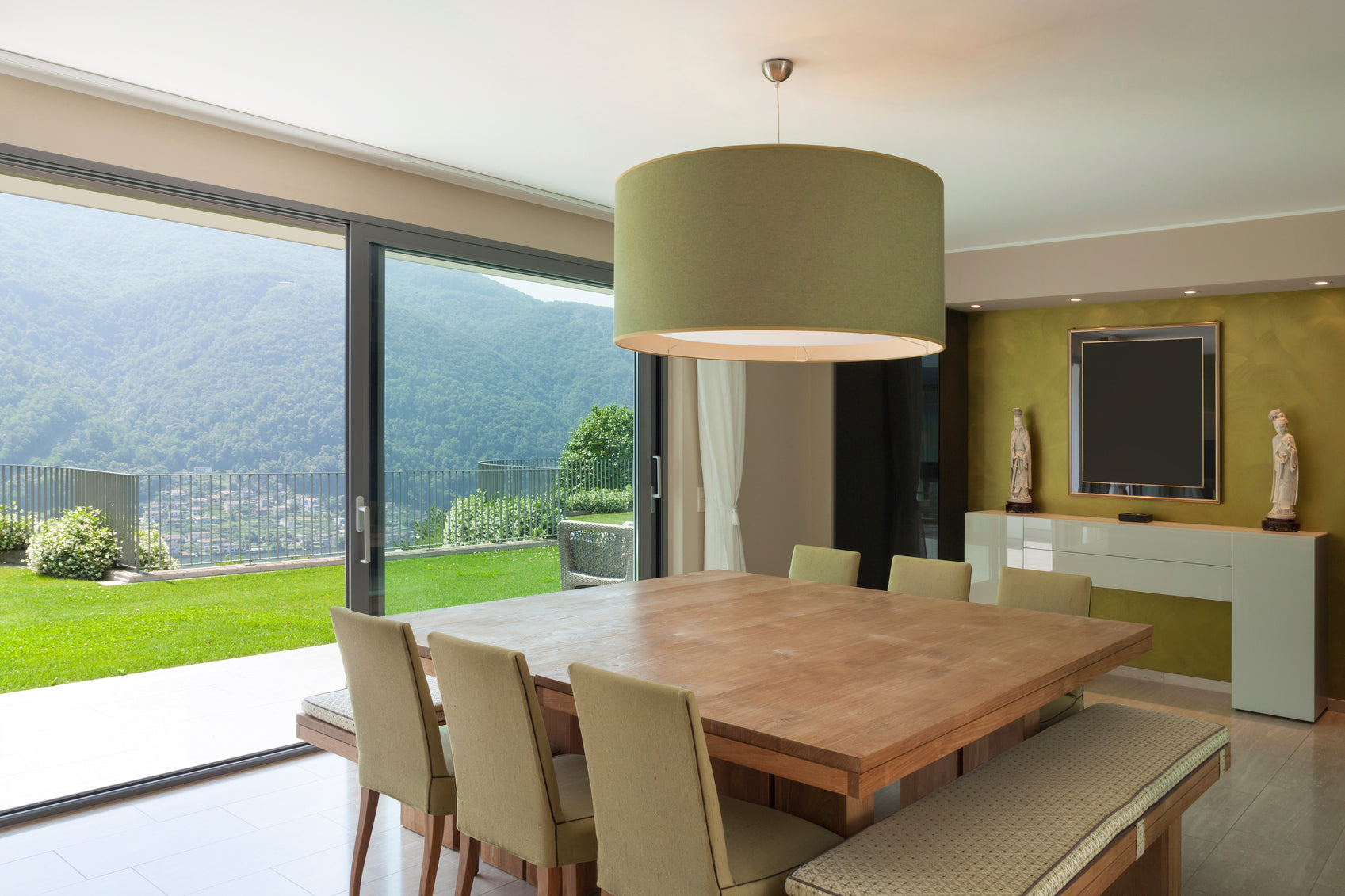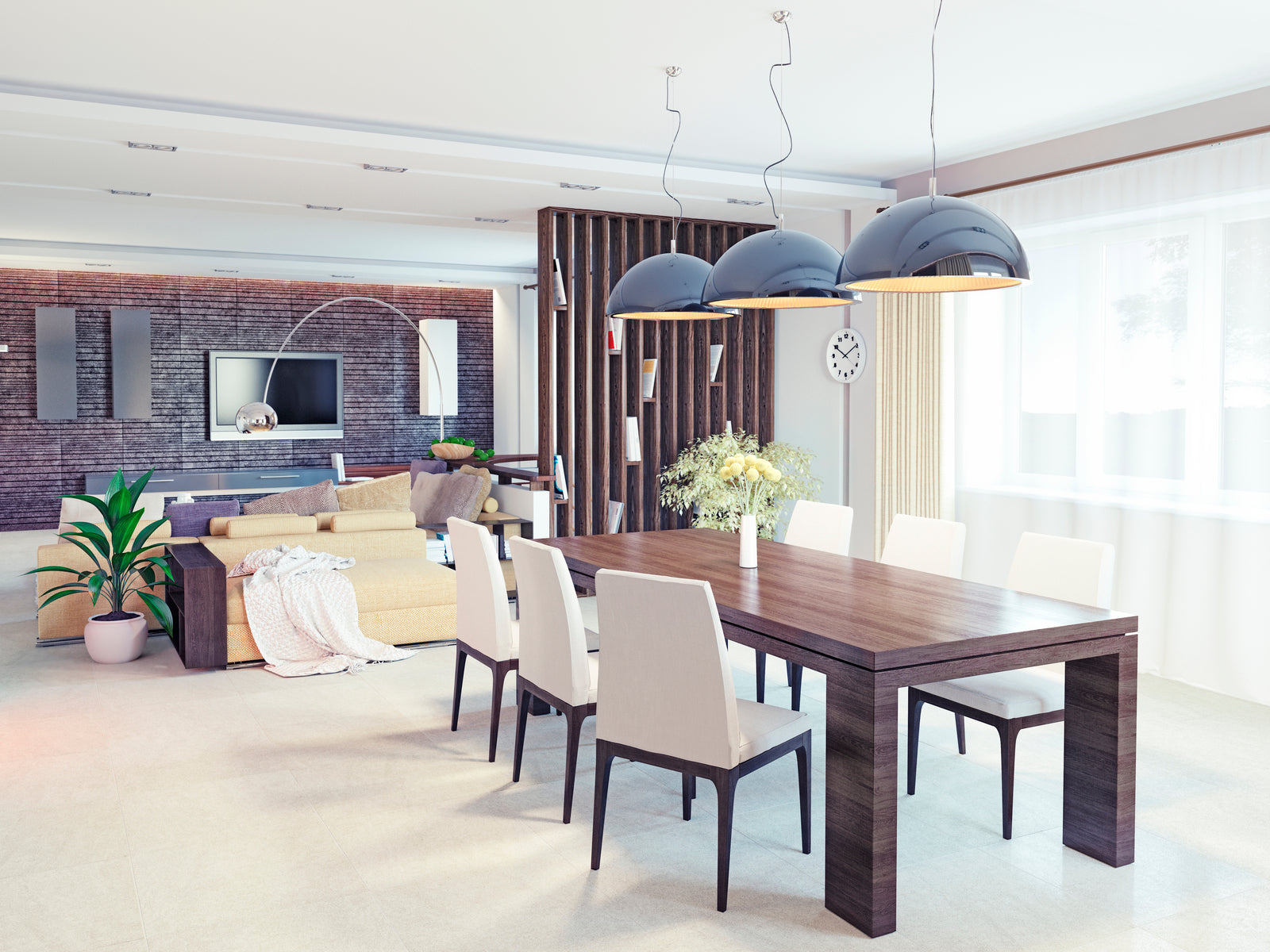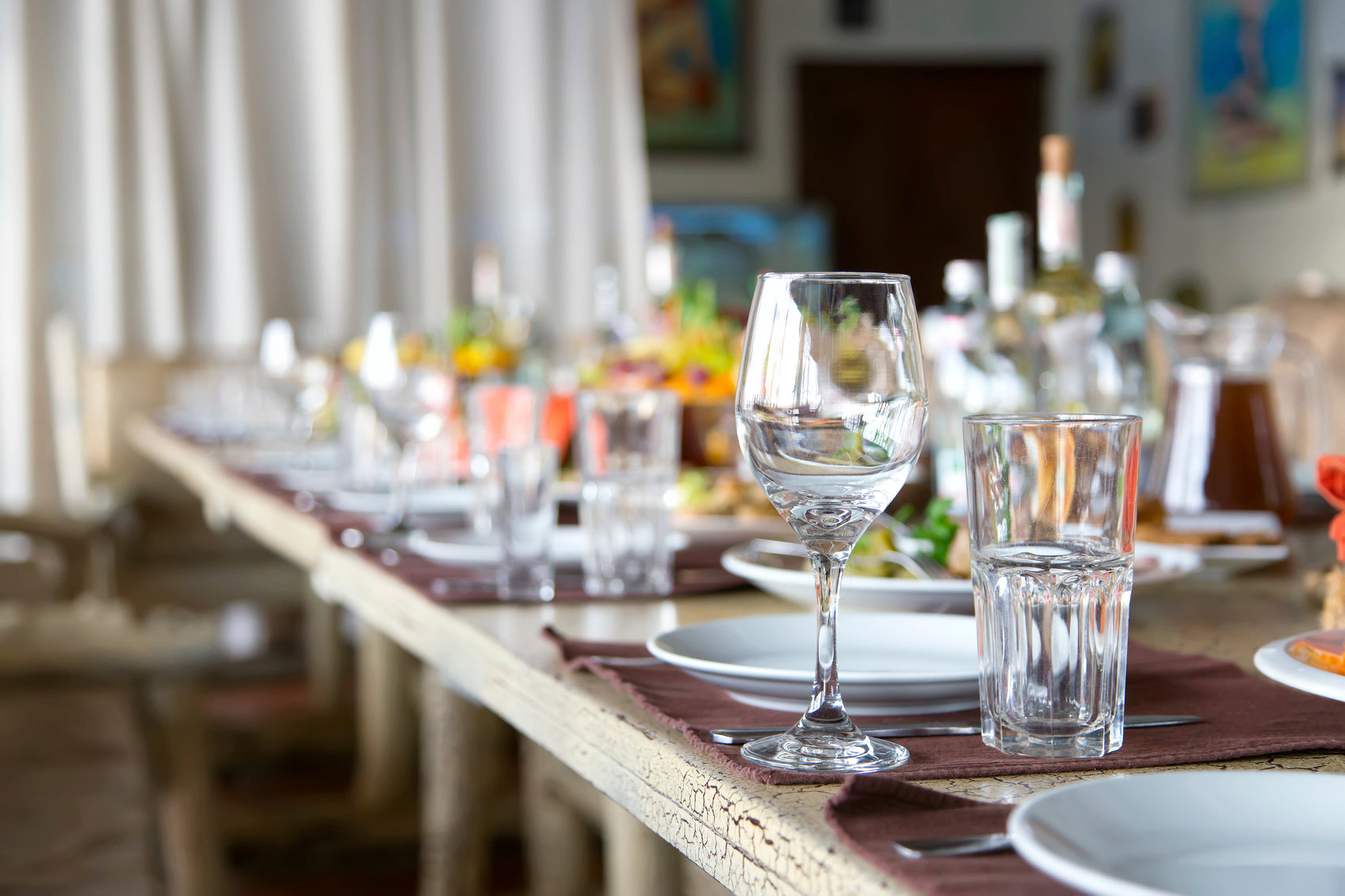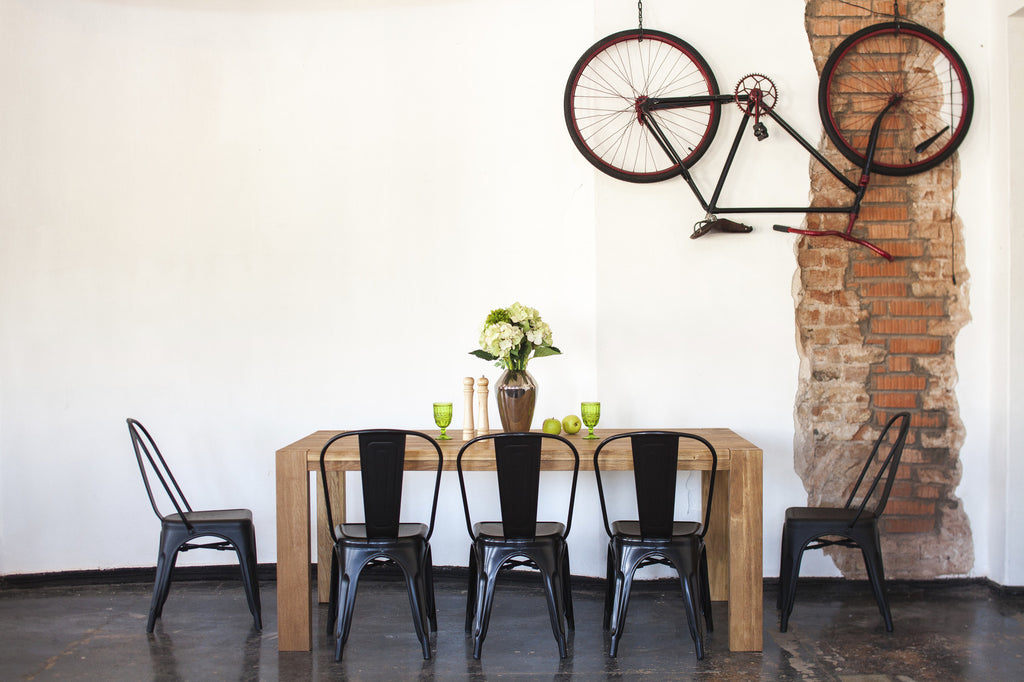Setting the Table: 10 Tips for Creating a Dashing Dining Room
Your dining room should be the pride of your home – it's where you entertain friends and family, store your best china, and spend a lot of your time. So doesn´t your dining room deserve to be the room where you invest most of your money and design skills? Follow our guide, and make the most of your dining room by creating a space to enjoy and show off.
1. Does your Dining Room Work with your Kitchen?
Many homes are built with their dining room and kitchen connected (either all one room or with a small divider) or right next to one another. This can certainly be used to your advantage. Before buying anything for your dining room, consider how the item will work with your kitchen. If you have one long room you may want to match the designs, or at least have them complement each another. You could also cut into kitchen space if you have a large dining table, or use your dining space to maximize your kitchen. If the two are separate you may want to store more (and invest more in storage units) in your kitchen, to keep the dining room spacious and airy.
2. Select the Right Table
The focus of the dining room is, of course, on the table. The type of dining table you choose will set the design for the rest of the room.
What size of table do you want? This depends on how big a space you have to work with. The larger a table is, the smaller it will make a room seem. Before selecting your table, consider what other furniture pieces you plan to use in your room and how much space they will take up. How many people will use the room at any one time? If you love entertaining, you may need a bigger table. If only one or two people will sit at the table you could sacrifice the valuable space for something else.
Second, think of the table shape you want. Dining tables are either square, rectangular, or circular. To create balance choose square tables for four or less people, and circular tables for six or less. Otherwise your table will start to feel cramped, or the center will be so large that guests will struggle to chat to each other. Rectangular tables are ideal for larger dining rooms.

3. Choose the Right Seating
Once you have your table it's time to select the seating that suits both the table and the room. Armless chairs work best with smaller tables and spaces, while larger spaces can handle chairs with arms and more ornate seating.
A vital – but often overlooked – factor to consider when choosing seating is how easy it will be to sit down and stand up. Aim to keep at least two feet of space between seats and the wall, giving everyone enough room to move comfortably. If you're really tight on space, consider bench seating or placing your dining table in a corner. A bench requires little to no movement of the actual sea, and pushing your table into a corner gives you more space. Remember though, that this is likely to cut off at least half your table. Even you're extremely tight for space, try high furniture, such as a high table and bar stools. This can open up your floor, and make the entire room feel larger.
4. Light Right
Many people choose a single overhead lighting source for their dining rooms. This can work well, but it is important to select a light fixture that lights the whole room (such as a chandelier). If you choose a single overhead light source, be sure to position it right above the table (or the table right under it). Centering your light over your table will make the room feel more balanced. If you need more light – this especially applies to larger dining rooms, where one source cannot possibly provide enough light – you can have multiple sources. Overhead recessed lighting or wall-mounted lamps work best for multiple lighting, as they don't take up any floor space.

Dimmers are great for dining rooms, as you can adjust the lighting for any occasion. You can buy dimmers for any style of lighting, though they usually work well with recessed lighting or a chandelier.
Mirrors can be just as useful for lighting a room as the lights themselves. In the right location mirrors will reflect light around a room, and make it seem more spacious. Mirrors can also be used to make the most of your natural lighting. Placing large mirrors on walls opposite windows will make increase the perception of natural light.
5. Store Smartly
Storage is often over-looked in the dining room. While you can store your dining ware in the kitchen, there are many ways to display china and other knick knacks elegantly in your dining room. It's best to avoid closed cabinets in most dining rooms. These will make the room feel smaller. Instead, opt for either glass cabinets or open shelving. If you do need some closed cabinet space, place it lower to the ground, where it will be less noticeable and where the cabinet can double as a table or display your treasures..
Use wine racks and bar storage to add a classic touch to any room. These free up space while adding a classic design element to any dining room.
6. Consider a Rug
Rugs can be a homely addition to any dining room. Ideally, the rug will be a couple of feet larger in every direction than your table to ensure the chairs sit comfortably on it. It's best to match your rug shape either with the shape of the table or the shape of the room. If these are the same shape, your choice is easy! This trick will make the room feel more harmonized.
Another tip is to pick a material that is easy to clean. You will likely have food spills and stains at some point. Certain fabrics handle spillage better, and darker colors are always best. To solve this a wood rug adds a modern flair to any room and is much easier to clean than a fabric rug.
7. Decorate and Accent in Style
Once you have all the staple pieces for your dining room, accents and décor will complete the picture.

In more formal dining spaces, many people opt for no table cloth as they can make a space look more casual and make your table look smaller. If the feature of the room is a quality wood table, it's a shame to cover it up. As an alternative, use either a table runner or individual place mats so you can still see the beauty of the table. For a quirky look, layer table mats of different sizes on top of one another. Table decorations are a cheap and easy way to change up the look of your dining room. You can rotate decorations throughout the year, and store everything in the room or in the kitchen.
Your walls are another key aspect of dining room decoration. The wall color you choose will set the feel of the room. Consider the furniture you have or plan to buy. Is it all one color? If so, your walls should be a different shade, and your trim another color. How much lighting do you have? Darker rooms will need more light; either natural or artificial. For a more modern look, use darker, bolder colors like maroon and dark brown. Light colors with light colors make a room look plain.
Finally, add an accent or two to finish off the décor. Opt for just one or two wall accents, such as a large piece of wall art or a clock, as too many will look cramped. You can also easily transform a dining room with a candle or two spaced around table and cabinets.
About the Author

1. Does your Dining Room Work with your Kitchen?
Many homes are built with their dining room and kitchen connected (either all one room or with a small divider) or right next to one another. This can certainly be used to your advantage. Before buying anything for your dining room, consider how the item will work with your kitchen. If you have one long room you may want to match the designs, or at least have them complement each another. You could also cut into kitchen space if you have a large dining table, or use your dining space to maximize your kitchen. If the two are separate you may want to store more (and invest more in storage units) in your kitchen, to keep the dining room spacious and airy.
2. Select the Right Table
The focus of the dining room is, of course, on the table. The type of dining table you choose will set the design for the rest of the room.
What size of table do you want? This depends on how big a space you have to work with. The larger a table is, the smaller it will make a room seem. Before selecting your table, consider what other furniture pieces you plan to use in your room and how much space they will take up. How many people will use the room at any one time? If you love entertaining, you may need a bigger table. If only one or two people will sit at the table you could sacrifice the valuable space for something else.
Second, think of the table shape you want. Dining tables are either square, rectangular, or circular. To create balance choose square tables for four or less people, and circular tables for six or less. Otherwise your table will start to feel cramped, or the center will be so large that guests will struggle to chat to each other. Rectangular tables are ideal for larger dining rooms.

3. Choose the Right Seating
Once you have your table it's time to select the seating that suits both the table and the room. Armless chairs work best with smaller tables and spaces, while larger spaces can handle chairs with arms and more ornate seating.
A vital – but often overlooked – factor to consider when choosing seating is how easy it will be to sit down and stand up. Aim to keep at least two feet of space between seats and the wall, giving everyone enough room to move comfortably. If you're really tight on space, consider bench seating or placing your dining table in a corner. A bench requires little to no movement of the actual sea, and pushing your table into a corner gives you more space. Remember though, that this is likely to cut off at least half your table. Even you're extremely tight for space, try high furniture, such as a high table and bar stools. This can open up your floor, and make the entire room feel larger.
4. Light Right
Many people choose a single overhead lighting source for their dining rooms. This can work well, but it is important to select a light fixture that lights the whole room (such as a chandelier). If you choose a single overhead light source, be sure to position it right above the table (or the table right under it). Centering your light over your table will make the room feel more balanced. If you need more light – this especially applies to larger dining rooms, where one source cannot possibly provide enough light – you can have multiple sources. Overhead recessed lighting or wall-mounted lamps work best for multiple lighting, as they don't take up any floor space.

Dimmers are great for dining rooms, as you can adjust the lighting for any occasion. You can buy dimmers for any style of lighting, though they usually work well with recessed lighting or a chandelier.
Mirrors can be just as useful for lighting a room as the lights themselves. In the right location mirrors will reflect light around a room, and make it seem more spacious. Mirrors can also be used to make the most of your natural lighting. Placing large mirrors on walls opposite windows will make increase the perception of natural light.
5. Store Smartly
Storage is often over-looked in the dining room. While you can store your dining ware in the kitchen, there are many ways to display china and other knick knacks elegantly in your dining room. It's best to avoid closed cabinets in most dining rooms. These will make the room feel smaller. Instead, opt for either glass cabinets or open shelving. If you do need some closed cabinet space, place it lower to the ground, where it will be less noticeable and where the cabinet can double as a table or display your treasures..
Use wine racks and bar storage to add a classic touch to any room. These free up space while adding a classic design element to any dining room.
6. Consider a Rug
Rugs can be a homely addition to any dining room. Ideally, the rug will be a couple of feet larger in every direction than your table to ensure the chairs sit comfortably on it. It's best to match your rug shape either with the shape of the table or the shape of the room. If these are the same shape, your choice is easy! This trick will make the room feel more harmonized.
Another tip is to pick a material that is easy to clean. You will likely have food spills and stains at some point. Certain fabrics handle spillage better, and darker colors are always best. To solve this a wood rug adds a modern flair to any room and is much easier to clean than a fabric rug.
7. Decorate and Accent in Style
Once you have all the staple pieces for your dining room, accents and décor will complete the picture.

In more formal dining spaces, many people opt for no table cloth as they can make a space look more casual and make your table look smaller. If the feature of the room is a quality wood table, it's a shame to cover it up. As an alternative, use either a table runner or individual place mats so you can still see the beauty of the table. For a quirky look, layer table mats of different sizes on top of one another. Table decorations are a cheap and easy way to change up the look of your dining room. You can rotate decorations throughout the year, and store everything in the room or in the kitchen.
Your walls are another key aspect of dining room decoration. The wall color you choose will set the feel of the room. Consider the furniture you have or plan to buy. Is it all one color? If so, your walls should be a different shade, and your trim another color. How much lighting do you have? Darker rooms will need more light; either natural or artificial. For a more modern look, use darker, bolder colors like maroon and dark brown. Light colors with light colors make a room look plain.
Finally, add an accent or two to finish off the décor. Opt for just one or two wall accents, such as a large piece of wall art or a clock, as too many will look cramped. You can also easily transform a dining room with a candle or two spaced around table and cabinets.
About the Author


